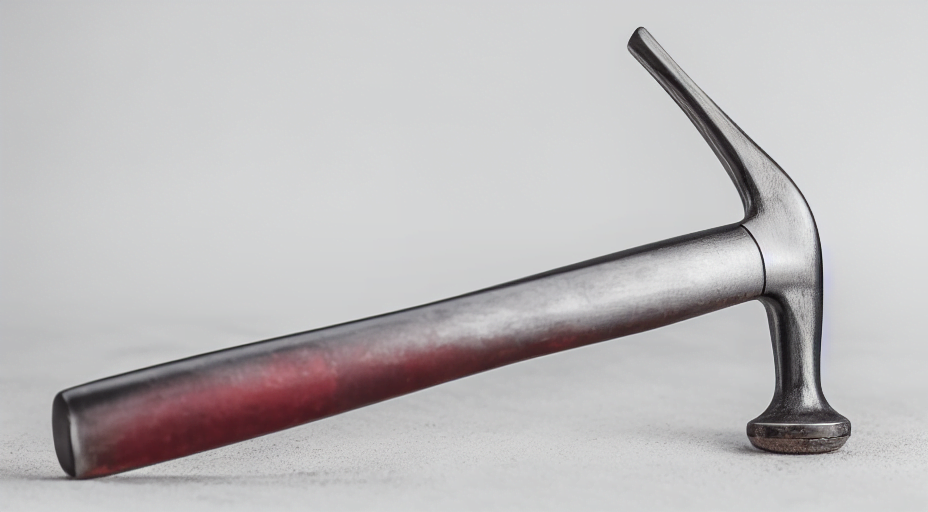Hammers for shoemaking
Hammers for shoemaking are essential tools tailored for constructing footwear. They help in lasting, shaping, and securing parts, ensuring a firm bond and precise assembly of various shoe components.
English Pattern Hammer

The English pattern hammer is uniquely designed for standing usage. When positioned with its face on a flat surface, the handle aligns parallel to the ground. This alignment is its signature feature. The face of its head is typically larger than that of the French hammer and lacks a significant curve. The opposite side of this hammer is slender, facilitating the heel-making process.
French Pattern Hammer

The French pattern hammer is crafted for those who work in a seated position. When its head face is laid flat against the ground, the handle's edge should touch the surface. This design—slightly taller than the English pattern—provides a counterbalance, ensuring precision during use, preventing unintended marks or dents on the leather. The hammer's reverse side is shaped like a straight, narrow hook, useful in heel crafting.
We utilize this specific hammer in the creation of every shoe type. Throughout our shoemaking courses, it plays a vital role in crafting insoles, soles, the lasting process, and heel construction. You can also use this hammer for folding the upper and flattening seams, as an alternative to the specialized folding hammer — one of the needed tools in shoemaking (a detailed description of this hammer can be found below). If you're interested in understanding how to use this hammer in the folding process, I invite you to explore my shoemaking article "How To Fold a Shoe Upper?! Shoemaking Steps".
Sole Hammer
Characterized by its double head—one larger than the other—the sole hammer is a weighty tool intended for attaching soles. Its design ensures that the shoe's sole remains mark-free post-application.
Note: We can substitute this hammer with the standard shoemaker’s hammer (either English or French patterns). Use the hammer's handle to secure the leather sole firmly to the bottom of the lasted upper. If you're wondering which types of leather are suitable for leather soles, be sure to check this out.
Heel Nailing Hammer
This hammer features a long, narrow head, designed to access challenging areas at the rear of completed shoes. Once the shoe lasts are removed, nails are strategically placed inside the shoe's back to secure the heels. This hammer, with its design, ensures the top line of the finished shoes remains undamaged in this tight space.
Folding Hammer

Specifically crafted for the folding process, this hammer aids in folding the upper and securing the edge while also flattening seams. Available with or without a handle, one side of the hammer presents a flat head, while the other side boasts a thin edge—ideal for flattening back seams on the shoe upper.
Explore our free shoemaking tutorial on flattening the back seam of the shoe upper, a crucial step in the shoe-making process: "What Shoemakers do, to achieve This perfect back seam". Also, in this shoe making tutorial you can learn on how to fold upper. If you're keen to discover more about the various tools and materials essential for crafting shoes and their usage, I invite you to delve into this article: "Shoe making supplies".
Magnetic Hammer for Pattern Making
![I work with a simple utility knife. What is important here is to use a good blade, for example, Japanese blades BD 100. To not waste too many blades you can sharpen them using this approach I teach in this post ‘’Simple Knife For Shoemaking Craft’’ Cardboard and paper In pattern making you will work with two types of the paper: cardboard and paper A4. From the cardboard, you will make all parts of your shoe upper and then use them to cut leather. Paper A4 you will need to use in order to check the correctness of your cardboard pattern(Basic Pattern). Why I recommend it, you can find in this post ‘’Save your money on leather, make shoes working with paper patterns [Video Tutorial]’’ Short nails and Hammer with magnetic edge magnetic hammer and nails for shoe pattern making](https://www.shoemakingcoursesonline.com/wp-content/uploads/2020/04/11.jpg)
Primarily used during pattern making, this hammer has a dual-purpose head: one side with a magnet and the other with a small flat face. Pattern makers can seamlessly fix nails into a pattern using the magnetic side, while the flat face ensures the nails are firmly embedded. This tool proves indispensable when working with simple paper to verify shoe pattern accuracy.
I recommend this magnetic hammer to all my students. However, if sourcing it proves challenging, there's a straightforward shoemaking trick you can employ using a regular hammer in its place. The technique is detailed in this article:"What You Have Been Missing Out In Shoemaking?[Shoe Pattern]"
Online shoe making stores
In the world of shoemaking tools, hammers can vary in handle design and head weight. It's very important to select the appropriate hammer for each specific stage of the shoemaking craft and if you want to learn about entire process of making shoes,materials abot shoe design, shoe types and much more, check this article: "How to make shoes".
There are several online stores dedicated to shoemaking, and here are a few where you can find some of these hammers. Additionally, I'd recommend checking out local stores in your area.
